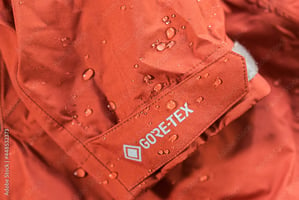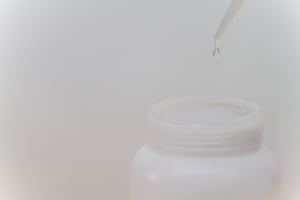Act.1 Advantages of Gore-Tex and maintenance requirements Gore-Tex is a waterproof and breathable...
Advantages and disadvantages of waterproof breathable fabrics like Gore-Tex
Gore-Tex is so great!
Since the introduction of Gore-Tex, our mountaineering activities have become much more comfortable. Until then, umbrellas were coated to prevent water from penetrating through the coating and wetting the clothes inside, but coated rain jackets were very uncomfortable and stuffy inside. The advent of GORE-TEX changed the industry, and has undoubtedly led to the development of today's mountaineering.
However, while breathable materials such as Gore-Tex have wonderful advantages, they also have disadvantages.
These will be explained including the structure of waterproof breathable fabrics such as Gore-Tex, because understanding the structure of waterproof breathable fabrics such as Gore-Tex will make it easier to understand their disadvantages.
Gore-Tex is not a fabric.
Knowing the structure of waterproof breathable fabrics such as Gore-Tex is the core of what we will discuss, so we will explain it first.
The body of Gore-Tex is not what we can see, although this may be slightly misleading. It is what is hidden inside the fabric that is the main body of GORE-TEX.
Gore-Tex, for example, is a membrane. It is similar to a film. This membrane is the waterproof and breathable body of GORE-TEX. We see the membrane protected by the fabric between the top and bottom.
The true disadvantage of Gore-Tex.
This is a very important structure, and it is the very thing that makes Gore-Tex a fatal disadvantage.
For example, if you could make a rain jacket using only the Gore-Tex membrane, it would require no maintenance. Since the GORE-TEX membrane is not prone to staining or settling, a simple water rinse of the jacket would be all that would be required to keep it in good condition. Moreover, since the membrane is chemically stable, there is no risk of deterioration even if the jacket is dried in the sun all the time. Not only that, but you don't have to worry about it being too humid. The GORE-TEX membrane itself is so stable that it will maintain its high performance.
What if a rain jacket is made only with GORE-TEX membrane?
However, making a rain jacket with only a GORE-TEX membrane creates other disadvantages that make it a poor product.
For example, if Gore-Tex is left bare, it will not be strong enough to resist physical damage such as abrasion and chafing during use, and may tear after just one use in the mountains.
However, let's say, for example, that the weight is ignored and the thickness is increased to prevent easy tearing. However, the bare Gore-Tex would not be comfortable to wear and would not feel pleasant against the skin.
Not only this, but there are several other disadvantages. That is why we do not make rain jackets with GORE-TEX membrane alone. We always use it sandwiched between fabrics.
Why Gore-Tex is affected by fabric on top and bottom?
The GORE-TEX membrane is a membrane, as explained earlier, and is a bit different from the fabric itself. It is essentially an internal membrane, although it can be said to be a fabric if it is sandwiched between fabrics on the top and bottom.
The fact that it is sandwiched between fabrics means that even if the GORE-TEX membrane itself does not change or deteriorate, it will be affected by changes in the fabrics on the top and bottom.
This is the primary reason why GORE-TEX requires maintenance.
If the membrane is covered with a non-breathable fabric, its performance will be compromised, no matter how breathable the GORE-TEX membrane itself is.
The top and bottom fabrics must not inhibit breathability.
Factors that hinder breathability and what you would do next?
There are several factors that can impede moisture permeability, but the main ones are contamination of the inner side fabrics and poor water repellency of the outer fabrics. Both of these factors clog the fibers and block the passage of moisture.
The disadvantages do not stop there. The loss of water repellency of the outer fabric causes the outer fabric to absorb water. While the inner fabric has a Gore-Tex membrane that does not allow water to pass through, the outer fabric will store water. This makes the rain jacket itself heavier. This makes the jacket itself heavier, and it also makes it easier for the body to get cold. Imagine wearing a T-shirt that has been soaked by rain. The water doesn't get through, so your body doesn't get wet, but the situation is similar. In fact, disposable rain jackets made of vinyl do not absorb water, and Gore-Tex, which has absorbed water, is worse than these jackets because it is not breathable. The reason is that both are not breathable.
So what can we do about it?
The answer is regular maintenance. It is to clean regularly to remove stains and perform water repellency restoration work on a regular basis.
Basically, cleaning should be done after every heavy use. And we recommend that the water repellency restoration work be done every season, depending on usage.
We are professionals of water repellent treatments.
We originally lent our rain jackets for climbing Mt. And we too have maintained our Gore-Tex rain jackets initially with waterproof sprays and Nikwax. But no matter how much we maintained them according to the manufacturer's description, they never returned to satisfactory water repellency.
We have experimented with many GORE-TEX jackets. In fact, we have ruined more than 100 Gore-Tex jackets. Fortunately we had a lot of Gore-Tex jackets that had lost their water repellency because we offered a rental service. This allowed us to discover the fatal point of waterproofing sprays and Nikwax. Simply put, they are different from the original water repellent treatment. Because they are different, they will never return to their original water-repellent state.
We have been researching how to return them to their original water-repellent state. This was not an easy task, but it took many years of development. This is how we have completed our water-repellent coating technology.



